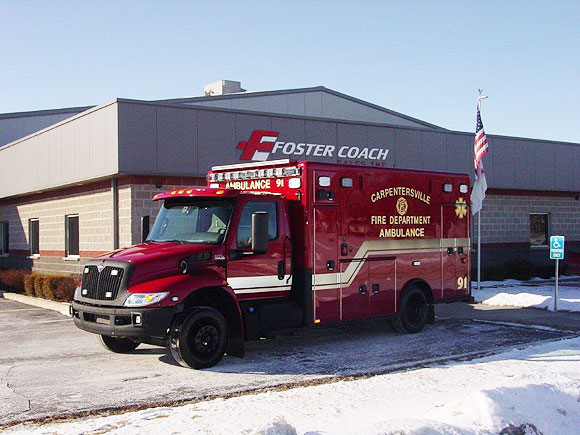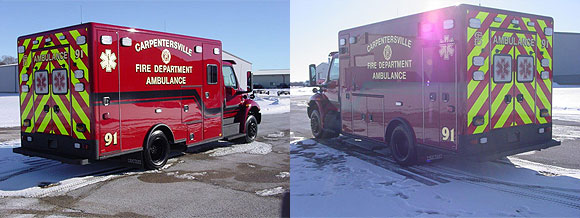From Steve Redick on day 2 of the 2-Alarm and Box Alarm fire in Bartlett, 2-3-22
Feb 4
Posted by Admin in Fire Service News | Comments off
From Steve Redick on day 2 of the 2-Alarm and Box Alarm fire in Bartlett, 2-3-22
Tags: Bartlett & Countryside Fire Protection District, chicagoareafire.com, Chicagoareafire.com/blog, document storage warehouse Access destroyed by fire, fire scene video, Steve Redick, warehouse destroyed by fire in Bartlett, warehouse fire in Bartlett
Excerpts from the Washingtonpost.com:
In many ways, KME was closing at the best possible time for its workers. The labor market was hot. Companies were desperate to hire. The roads outside the KME factory here in the foothills of the Pocono mountains were dotted with “Help wanted” signs. But something harder to measure was being lost.
Workers across the country have been quitting their jobs at historic rates during the pandemic — with manufacturing workers leaving at the highest clip, according to federal data. Many factory jobs, after years of sluggish wage growth, now offer pay on par with the service sector. And companies still wield enormous power over workers.
At KME, the allure of working for the hometown company had been fading for several years, ever since a private equity firm bought the company from a local family. And it became clear to many that the kind of blue-collar jobs that sustained places like Nesquehoning were being streamlined out of existence. The fate of KME was no longer in local hands after it was sold in 2016. The new owners went public a few months later.
Today, KME is just one of six firetruck brands owned by a single company called REV Group. In the fall, its executives announced that the Nesquehoning plant would close and production would shift to other states.
KME — also known as Kovatch Mobile Equipment — got its start when Sonny Kovatch returned from the Army and opened a small garage in his hometown in 1946. He added a dealership. He started making trucks. He kept growing, adding in oil refueling trucks and fire engines.
Kovatch grew KME into the country’s largest private manufacturer of fire apparatus. The company sold every type of truck. It sold to small volunteer agencies and major departments in cities such as Atlanta, Boston and Philadelphia. Los Angeles County bought 250 firetrucks. New York City bought nearly 100. A couple of years ago, KME delivered two new trucks to the D.C. fire department. The small fire departments in rural Pennsylvania were especially loyal.
At one point, the world headquarters of KME in Nesquehoning employed more than 700 people in a town of 3,300. When times were good, everyone knew to stay off the roads about 3:30 p.m. on weekdays, when the day shift let out. The surge in traffic fed the town’s three gas stations and a small grocery store, amenities that residents said they probably wouldn’t have without KME.The town still had problems. Poverty was persistent. Some of the houses sitting tight by the road in the heart of town looked tired, their front porches worn and the siding faded. A town that was once home to six or seven churches now had two or three. There were fewer neighborhood bars, too.
KME sustained the town in other ways. It helped sponsor the local Anthracite Little League — the company name splashed across jerseys and posted on an outfield banner at the town’s baseball diamond. There was a scholarship fund named after Sonny Kovatch. The family also donated money for new baseball bats and football helmets. They chipped in to refurbish the high school’s weight room.
The company’s success always felt like a hedge against the decline of the coal industry and the town’s remote location well off the turnpike. Local leaders had tried different initiatives to attract new industries to town, but none of the efforts worked like making firetrucks.
Employees tended to stay at KME. Craftsmen refined their skills. Painters made sure the trucks gleamed. The work stayed interesting because the factory was not run like a typical assembly line. The bends in the water pipes were done by hand, not with a robot. Employees learned new skills rather than doing small, repetitive tasks. When KME was family-owned, a job at the factory was something to hold on to.The pride in having a job at the firetruck factory trickled down to the workers’ children, too. Teachers could see it. The school district also depended on KME for its tax base.
The impact of the factory’s closing was still being worked out. But the Panther Valley School District was already in trouble. Its six-year college graduation rate was under 12 percent. The district was severely underfunded, despite having the state’s 10th-highest property tax rate. Now, it was one of several districts suing the state over education funding.
Even as Panther Valley saw property assessments increase in 2020, the amount of property tax revenue going to the schools declined because so many other properties fell into blight.In 2015, KME worked on a coveted contract to supply and service more than 90 pumpers to the Fire Department of New York — the nation’s largest. Getting its business was a big deal — a seal of approval for the company and a shot in the arm for the town. It was one year into that New York City contract that the Kovatch family announced they were selling. The price was never revealed. The family declined to comment for this article. But by the time of the sale, Sonny Kovatch had been dead four years, and his son, John Kovatch III, was running the operations.
The new owner was REV Group, which was itself a new company, created by the private-equity firm American Industrial Partners to run the specialty-vehicle makers it had snapped up. A few months later, REV Group went public in a $275 million IPO.
REV Group’s track record could be summed up by a graphic in its 2021 annual report, titled “A history of consolidation.” The Brookfield, Wis.-headquartered company today owns 17 firms.
In recent years, the company struggled to make money with KME. It lost $1 million a month in the past two years trying to turn it around. It was a culture clash, according to workers and officials in Nesquehoning. REV tried to implement a traditional production line with increased automation. It made business sense. REV could slash costs if it simplified tasks. But the business tactics collided with what made KME stand out.
The company started outsourcing some of its service work. And the new KME wasn’t afraid to fire people. In 2019, it laid off 15 percent of its workforce. In August, REV said it planned to close the Nesquehoning plant by April. The six-month warning was unusual. The company dangled $5,000 bonuses if workers stayed on.
thanks Martin
Tags: KME Fire Apparatus, Kovatch Mobile Equipment, REV Group® Announces Plans to Shift KME® Production to Other REV Fire Group Facilities, Sonny Kovatch
Feb 4
Posted by Admin in Ambulance photos, Fire Department News, New Delivery | 3 Comments
From the FosterCoachSals website:

rsville FD Ambulance 91e Foster Coach Sales photo

Foster Coach Sales photos
thanks Martin
Tags: Carpentersville FD Ambulance 91, Carpentersville Fire Department, Foster Coach Sales, new ambulance for Carpentersville
You are currently browsing the archives for Friday, February 4th, 2022

For the finest department portraits and composites contact Tim Olk or Larry Shapiro.
Arclite theme by digitalnature | powered by WordPress